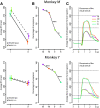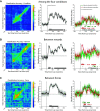Neurons in the Monkey's Subthalamic Nucleus Differentially Encode Motivation and Effort
- PMID: 35105674
- PMCID: PMC8944229
- DOI: 10.1523/JNEUROSCI.0281-21.2021
Neurons in the Monkey's Subthalamic Nucleus Differentially Encode Motivation and Effort
Abstract
The understanding of the electrophysiological properties of the subthalamic nucleus (STN) neurons is crucial since it represents the main target of deep brain stimulation for the treatment of Parkinson's disease and obsessive-compulsive disorders. The study of its nonmotor properties could shed light on the cognitive and motivational alterations possibly encountered after stimulation. In this study, we recorded the activity of STN neurons in two male behaving monkeys (Macaca mulatta) while they performed a visuomotor motivational task in which visual cues indicated which amount of force was required to obtain which amount of reward. Our results evidenced force- and reward-modulated neurons. After the occurrence of the visual stimuli, the force-modulated neurons mainly fired when a high effort was required. Differently, the activity of the population of reward-modulated neurons encoded the motivational value of the stimuli. This population consisted of neurons increasing or decreasing their activity according to the motivational ranking of the task conditions. Both populations could play complementary roles, one in the implementation of the difficulty of the action and the other in enhancing or slowing its execution based on the subjective value of each condition.SIGNIFICANCE STATEMENT An increasing number of studies confers a role to the subthalamic nucleus (STN) in motivational and reward-related processes. However, the electrophysiological bases of such properties at the neuronal level remain unclear. The present study investigated the modulation of STN neuronal activity in monkeys performing a motivational task in which the force to produce and the reward obtained were manipulated. We found two main populations of neurons, one modulated by the effort required and the other integrating the motivational subjective value of the stimuli. This last population could help at improving decision-making to act or not, depending on the subjective value set by the motivational context. This highlights the pivotal role of STN in the valuation of cost/benefit for decision-making processes.
Keywords: effort; electrophysiology; monkey; motivation; reward; subthalamic nucleus.
Copyright © 2022 the authors.
Figures






References
-
- Baunez C (2016) The subthalamic nucleus and reward-related processes. In: Innovations in cognitive neuroscience. The basal ganglia: novel perspectives on motor and cognitive functions (Soghomonian J-J, ed), pp 319–337. Cham, Switzerland: Springer.
